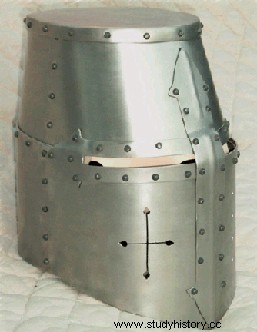The helm is an emblematic cavalry helmet of chivalry, protecting the whole head.

During Antiquity, the Greeks already wore a helmet recalling by its forms the medieval helm and the Roman helmet wrapped around the skull in exactly the same way, but they both left the face uncovered. When it first appeared at the end of the 12th century, the helmet was first made up of a simple steel cap to which was attached a mask covering the face, then it evolved by completely enclosing the head for better protection. The conical nasal helmet (of Norman origin), used until then in Europe since the 10th century, will definitely go out of use in the 13th century.
Successive improvements to the helmet, which consisted in covering more and more of the face, made it difficult to identify its owner. We can see, on the Bayeux tapestry, Guillaume de Normandie forced to raise his helmet to show his men that he is still alive. It is believed that this gave rise to heraldry, the science of coats of arms, in order to identify combatants by their coat of arms.
The helmet could show a certain artistic research, with floral or geometric patterns obtained by painting, addition of supernumerary rivets or decorative metal reliefs, sculpture of the cross reinforcing the facial part, etc. At the opening of the tournaments, the helms of the participants were surmounted by a crest, like the ancient helmets, although sometimes much more worked. The whole was placed near the emblazoned shield for the show of the helms, a parade during which the heralds identified the jousters, and the ladies could dismiss the knights who had disrespected the fair sex.
Form and evolution
At the beginning of the 13th century, in order to better protect the face, the cylindrical helmet was created, wrapping the entire head with slits for the eyes. Although few blunt weapons could then come to the knight's head, the flat top was a step backwards from the helmet previously in use. Improved forging techniques during the 13th century allowed a return to a conical shape, which made it less vulnerable to blows to the top of the head. Eventually, the helmet took on an ogival shape, known as a sugar loaf in the 14th century.
At the same time, in order to leave fewer outlets for the arrows and especially the spears of the adversaries charging with the new technique of the prone spear, the ventilation openings, as well as those for the view, were greatly reduced in number for the first and in size for seconds. This helm was heavy and made it difficult to breathe which explains why it was only worn during combat.
Around the beginning of the 14th century, the face mask became mobile, thus allowing the face to be uncovered outside of critical moments. This latest development, considerably improving the comfort of the knight, foreshadowed the arrival of the bascinet, lighter, better designed to deflect blows and whose visor greatly facilitated breathing.
Towards the end of the 14th century, a new highly reinforced helm appeared:the toad-head helm. Its receding surfaces made it possible to deflect blows and it was widely used in tournaments and games.
The helmet completely ceased to be used at the end of the 15th century, being replaced by the armet and the salad.
